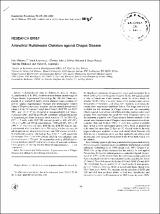Aminothiol multidentate chelators against Chagas disease

View/
Date
2000Author
Deharo, Eric
Loyevsky, Mark
Christy, John
Balanza, Elfride
Ruiz, Grace
Muñoz, Victoria
Gordeuk, Victor R
Metadata
Show full item recordAbstract
Abstract
Three compounds of an aminothiol family of iron chelators were examined for activity against trypomastigote (human) and epimastigote (vector) forms of Trypanosoma cruzi: tetraethyl and tetramethyl derivatives of ethane-1,2-bis (N-1-amino-3-ethyl butyl-3-thiol) (BAT-TE and BAT-TM) and N',N',N'-tris-(2-methyl-2-mercaptopriopyl)- 1.4.7-triazacyclonane (TAT). BAT-TE at 270 µM completely arrested the growth of trypomastigote forms in mouse blood stored at 4º C for 24 h (IC(50) 67.7+/-7 µM), while BAT-TM arrested growth at 630 µM (IC(50) 158+/-17 µM) and TAT at concentrations >800 µM (IC(50) 415+/-55 µM). In T. cruzi-infected mice, BAT-TE and BAT-TM had no anti-trypanosomal activity in doses up to 200 mg/kg, whether the route of administration was intraperitoneal or oral, and TAT was not tested due to insufficient quantity. TAT had an IC(50) of 52+/-7 µM against the epimastigote forms while BAT-TM and BAT-TE were inhibitory only at concentrations >250 µM. The trypanocidal activity of BAT derivatives in blood stored at 4º C makes these compounds potential candidates for the purpose of clearing donated blood of trypomastigotes.
